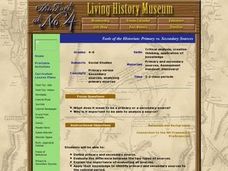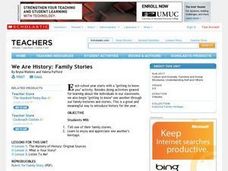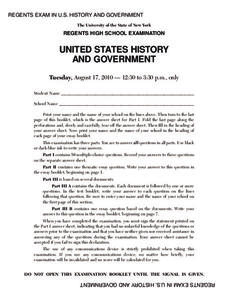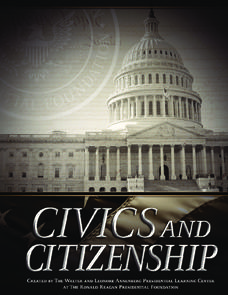Curated OER
Can you Prove it?
Tenth graders examine how primary source documents help authors and museum curators interpret historic events. In this social studies lesson, 10th graders research primary source documents. Students create a powerpoint to present their...
PBS
1000 Words
A picture really can speak a thousand words—no matter how old! Scholars become history detectives as they learn how to analyze historical photos and evidence to uncover the past. The fun hands-on activity makes history come alive through...
Curated OER
Revolt
Knowing what questions to ask and knowing how to organize information found is often difficult for young researchers. Consider using this worksheet to help guide a revolutions research project. Researchers are first directed to examine...
Briscoe Center for American History
Applying the SOAPS Method of Analyzing Historical Documents
Young historians use the SOAPS (Speaker, Occasion, Audience, Purpose, Subject) method of questioning to determine the historical value of primary source documents. The third in a series of five lessons that model for learners how...
Curated OER
Tools of the Historian: Primary vs. Secondary Sources
Students identify the difference between primary and secondary sources. They discuss the importance of evaluating all sources they might use. They read primary and secondary sources that relate to the colonial period.
Curated OER
We Are History: Family Stories
Students examine their own family heritage and share family stories with the class. They differentiate between primary and secondary sources, and bring in and write about three artifacts from their family. They conduct an interview...
Curated OER
Anti-Slavery and Reform-Related Sources
Fifth graders use primary sources to explore events witnessed by ordinary people. In this primary documents lesson, 5th graders answer critical thinking questions based on their documents. Students recognize the difference between...
New York State Education Department
US History and Government Examination: August 2010
Geography has played a complex role in America history. The Atlantic Ocean has served as a buffer to protect the United States from European Wars, but its proximity to Cuba, however, left it vulnerable to nuclear war during the Cuban...
New York State Education Department
Global History and Geography Examination: January 2011
Using primary and secondary sources—including classics such as the Communist Manifesto—class members consider the effects of these ideas on the course of history. Another essay prompt explores geography and history, while multiple-choice...
National Woman's History Museum
Defying British Rule: Women's Contributions to The American Revolution
Primary and secondary sources are the focus of a instructional activity that showcases the important role women played during the American Revolution. Pairs review sources and discuss their findings. A close-reading of an informational...
Curated OER
Abigail’s War: The American Revolution through the Eyes of Abigail Adams
Four lessons, performed over four weeks, pay special attention to Abigail Adams. Fifth graders analyze primary and secondary sources, read texts, discuss and write about Adams' experience during the Revolutionary War—the Battle of Bunker...
Curated OER
John Smith’s Map of the Chesapeake Bay
Young geographers travel back through time with primary source and map analysis and envision Captain John Smith's arrival at the Chesapeake Bay.
Idaho State Department of Education
Lessons for Social Studies Educators
Point of view, purpose, and tone: three concepts readers of primary and secondary source materials must take into account when examining documents. Class members view a PowerPoint presentation and use the SOAPS strategy to identify an...
Australian National Schools Network
Civics and Citizenship
What is a good citizen? Here is a fantastic unit of ten lessons that will thoroughly cover the concept of civics and citizenship in your class. Examples of activities include learning stations, primary and secondary source analysis of...
NYC Department of Records
Citizenship and Elections: The Importance of a Ballot
Approximately 58 prcent of those eligible voted in the 2016 US Presidential election. In an attempt to impress upon learners the importance of voting and voting rights, class members examine primary source documents related to the...
Los Angeles Unified School District
World History Medieval and Early Modern Times
A slew of graphic organizers, worksheets, and student activities are packaged here for your world history pupils. From comparing and contrasting the Qur'an and Sunnah, studying cultural diffusion across eastern nations, or examining the...
Curated OER
Primary Sources and Protagonists: A Native American Literature Unit
Introduce your middle schoolers to the lives of past Native Americans. First, learners work together to put photographs in a sequence. Then, using their sequence, they create stories to share with the whole class. No matter how old your...
Echoes & Reflections
Perpetrators, Collaborators, and Bystanders
After the Holocaust, the world grappled with how to bring justice to the Nazis. But what to do with the thousands—if not millions—who allowed it to happen? Young historians consider the issues of guilt, collaboration, and responsibility...
Canadian War Museum
Comparing Primary and Secondary Sources
This simple two-day lesson introduces learners to the differences between primary and secondary sources. The lesson includes group work that explores the similarities and differences, and the advantages and disadvantages of primary and...
Curated OER
The Movement Before the Movement: Civil Rights Activism in the 1940s
Many educators focus on the civil rights movement as it occurred after Rosa Parks incited the bus boycott. Extend the understanding of the fight for civil rights in the United States with this post-WWII lesson. Learners examine and...
Curated OER
Slavery in America at the Time of the Civil War: Sources
Students discover how to use primary and secondary sources in research. In this Civil War lesson plan, students conduct research on slavery as they distinguish between primary and secondary sources regarding the same events.
Curated OER
Signature History
Students review the meaning and application of primary and secondary sources in research. They determine how researchers locate primary source documents before looking at signatures as a validating factor on many primary sources....
Curated OER
Lewis and Clark in Columbia River Country
Students interpret historical evidence presented in primary and secondary resources. In this research skills lesson, students research the death of Meriwether Lewis using forensic evidence presented in primary...
Facing History and Ourselves
Analyzing Historical Evidence
High schoolers examine World War I war crimes. In this world history instructional activity, students use primary and secondary sources to research and understand the systematic nature of the Armenian Genocide. High schoolers reflect on...

























